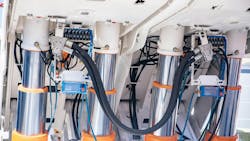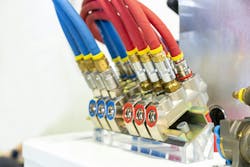Pneumatic Control for Hydraulic Systems: Benefits and Applications
Pneumatic control is one of several methods which can be used for hydraulic systems. “Every hydraulic system requires some sort of control system,” said Steve Weber, Regional Application Specialist at Sun Hydraulics.
These can include manually actuated valves or electrically actuated solenoid valves – commonly referred to as electrohydraulic valves – both of which can be switching or proportional. Commands are sent from human machine interfaces (HMI) such as electronic joysticks and programmable touchscreens as well as programmable logic controllers (PLCs) or industrial computers.
“Another means of controlling a hydraulic system is pneumatics,” he said. “Benefits from using pneumatics range from convenience to safety.”
The method chosen typically depends on which best suits the application at hand. Understanding when to use pneumatic control and the benefits it can provide can help determine if it is the right option for controlling a hydraulic system.
Pressure Requirements Determine When Pneumatic Control is the Right Choice
In a pneumatically controlled hydraulic system, an external pneumatic pressure signal controls the system’s hydraulic pressure, providing the same function and performance as hydro-mechanical or electro-hydraulic control options.
Knowing the pressure and how well the pneumatic pressure is regulated are the key determining factors when deciding whether to use pneumatic control for hydraulic systems, said Weber. In addition, it is important to know the hydraulic pressure being controlled.
“It is key to know the hydraulic system pressure throughout the operation of the machine and to know the regulated pneumatic pressure,” he said. However, one of the biggest challenges is “understanding how the hydraulic pressure dictates the pneumatic pressure required for proper function of the pneumatically controlled hydraulic valve.
“Pneumatically controlled hydraulic valves typically require a minimum of 50 psi and up to 100 psi pneumatic pressure,” he explained. “But this is dependent upon the hydraulic pressure.”
Weber noted that Sun Hydraulics offers various pneumatic actuated relief and directional control valves for use with hydraulic systems. Direct-acting versions are available for flows up to 2 gpm (7.5 lpm) while the pilot-operated relief valves are for flows up to 200 gpm (760 lpm). “Pressure ratios for pneumatically controlled hydraulic relief [valves] are 50:1 and 75:1 allowing for the readily available pneumatic pressure to control up to 5,000 psi hydraulic pressure,” he said.
Advantages of Using Pneumatically Controlled Hydraulic Systems
Pneumatically controlled hydraulic systems can benefit many applications, especially those where safety may be a concern or where pneumatics is already being utilized.
Weber said many industrial machines rely upon pneumatic controls. “These machines may be hydraulically actuated but also have some pneumatics on them,” he explained. “It can sometimes be more convenient to control the hydraulic system with pneumatics in this example over introducing a new control system such as electro-hydraulic valves.”
In this situation, there is no need to install additional equipment as all necessary components for pneumatic supply are already available. This not only eases implementation for machine owners but also reduces potential installation costs. An electro-hydraulic system, on the other hand, would require the installation of electrical wires, power supplies and other accessories which could drive up costs.
However, pneumatically controlled systems tend to have a slower dynamic response time compared to electro-hydraulics which should be taken into account based on the application’s requirements.
Weber said pneumatic control for hydraulic systems can also be the right marriage of technologies for hazardous environments where the use of explosion proof coils for electro-hydraulic valves would be required. “These ATEX/CSA rated explosion proof (EX) coils can be very expensive,” he said. “The use of pneumatic control might be a cost-effective option that provides the needed safety in these environments.”
Examples of these applications outlined by Sun Hydraulics include:
- oil drilling platforms
- oil and gas handling equipment
- chemical industry equipment
- dust-laden atmospheres (grain elevators)
- vehicular lifts
- sawmills.
As there are often combustible or explosive materials present in these types of applications, electrical devices used in them are required to meet “Intrinsically Safe” or “Explosion Proof” standards. This means they are designed to prevent heat or a spark sufficient to cause an explosion, even if the device is worn or damaged.
“Applications where heat generation is problematic from high duty cycle use of a solenoid coil might be solved with pneumatic control,” said Weber.
Environments with strong electromagnetic fields can be a concern as well if using electro-hydraulic control. Large currents or “noise” can be created which can lead to false signals being sent to sensitive electro-hydraulic devices.
Benefits of Using Pneumatic Control
Pneumatic control for hydraulic systems can offer several benefits over electro-hydraulic control, including:
- cost-efficiency,
- simplified installation,
- reduced space claim, and
- increased safety.
Pneumatically controlled systems can offer a better fit in hazardous applications because of the lower cost associated with the pneumatic lines compared to the electrical wires and other accessories. They are also not susceptible to the noise caused by electromagnetic fields because pneumatic control lines can be rubber or elastomeric tubes which makes them an electrical insulator.
In addition, Weber noted that some pneumatically controlled hydraulic valves can offer a size advantage over solenoid operated hydraulic valves. This could benefit the trend toward more compact hydraulic system designs as machine space constraints increase, particularly in mobile applications.
“Virtually any application that uses both hydraulic actuators and pneumatic controls could possibly marry these two systems by using a pneumatically controlled hydraulic valve,” he concluded.
About the Author
Sara Jensen
Executive Editor, Power & Motion
Sara Jensen is executive editor of Power & Motion, directing expanded coverage into the modern fluid power space, as well as mechatronic and smart technologies. She has over 15 years of publishing experience. Prior to Power & Motion she spent 11 years with a trade publication for engineers of heavy-duty equipment, the last 3 of which were as the editor and brand lead. Over the course of her time in the B2B industry, Sara has gained an extensive knowledge of various heavy-duty equipment industries — including construction, agriculture, mining and on-road trucks —along with the systems and market trends which impact them such as fluid power and electronic motion control technologies.
You can follow Sara and Power & Motion via the following social media handles:
X (formerly Twitter): @TechnlgyEditor and @PowerMotionTech
LinkedIn: @SaraJensen and @Power&Motion
Facebook: @PowerMotionTech

Leaders relevant to this article:



